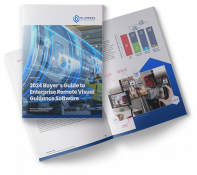Help Lightning Blog
Best Smart Glasses 2023: What’s New and Notable

The technology sector has been buzzing over the promise of smart glasses for some time now. We’ve seen excitement over various models of smart glasses, starting with the introduction of Google Glass in 2012. Since then, the market has become crowded with products from RealWear, Vuzix and Microsoft, just to name a few. The best smart glasses of 2023 create true extended reality/mixed reality (XR/MR) experiences for users. In contrast to virtual reality — which totally submerges the user into a computer-generated world of visual and audio stimuli — XR/MR overlays information onto the user’s view of the real world. Smart glasses make science-fiction experiences, like those from the movies Terminator and Iron Man, a reality.
State of the Smart Glasses Market in 2023
At Help Lightning, we follow the smart glasses market closely. We’re constantly looking for better ways to use AR glasses for field service and help our clients deliver outstanding customer service experiences. Our remote assistance software is currently supported on HoloLens 2, Vuzix, RealWear, Six15, and Zebra devices. Here are some things we’ve observed:
- Smart glasses generally don’t have the same kind of touch interface that iOS and Android users are used to. Instead, smart glasses apps are controlled via voice commands, specialized inputs (like small touchpads on the sides of the glasses) and remote apps that run on paired smartphones.
- Some smart glasses, like Vuzix, Zebra, and RealWear models, have small viewports. Users have to switch their focus between the task at hand in the real world and the small screen of the smart glasses, which they usually view with their dominant eye. It takes most users some time to get comfortable with switching focus back and forth.
- Other smart glasses are designed to superimpose XR data anywhere in the user’s field of view. One example of this is the Microsoft HoloLens 2, which is a goggle-style headset designed to cover your entire field of view. A health care or manufacturing user would likely find this to be more natural and comfortable. The user looks through a semi-transparent lens, onto which the device projects the user interface. This produces a Minority Report-type experience. HoloLens also tracks the user’s hand movement to provide an intuitive gesture-based interface.
Beyond 2023
The market for smart glasses is growing, and major players are getting in on it.
Epson, a 10-year veteran in the AR space, has upped their game with the latest Moverio BT-45CS smart glasses delivering advanced image quality in a binocular display with improved performance and wearability. The Moverio glasses are purpose-built for mission-critical tasks including troubleshooting, maintenance, inspection, and training. Supporting hands-free, “see-what-I-see” collaboration between on-site technicians and remote experts, the Moverio BT-45CS touts enhanced efficiency, improved safety and reduced downtime while on the job.
In early June of 2023, Apple made the long awaited announcement that they are officially in the smart glasses space with the release of their Vision Pro spatial-computing glasses. Apple’s Vision Pro makes it easy to collaborate and connect wherever you are. FaceTime video tiles are life-size, and as new people join, the call simply expands in your room. Within FaceTime, you can also use apps to collaborate with colleagues on the same documents simultaneously.
Other major computer companies that have demonstrated smart glasses at recent trade shows include Lenovo, Qualcomm, Oppo and Xiaomi.
Much of the smart glasses software and hardware available today still needs refinement before they impact our day-to-day lives in a significant way. But the technology is progressing — one Forbes writer called what he tried out at the recent CES 2023 trade show “astonishingly good” — and the sweet spot where functionality and affordability meet may be just a few years away. This is exciting news for looking to expand their suite of enterprise collaboration tools.
Climbing Out of the Trough of Disillusionment
In recent years, the market response to smart glasses has been tepid. The initial enthusiasm we saw with Google Glass in 2012 has given way to a “trough of disillusionment.” People are thinking about how this technology can solve real problems while not being cumbersome or impractical. At Help Lightning, we believe there’s real promise in creating amazing smart glasses remote assistance experiences — that’s our primary focus. To maximize adoption, smart glasses have to be designed with a primary focus on the user’s experience. They should be simple, intuitive, practical, and “just work.” An emphasis on user experience, both in the hardware and the software, will make smart glasses an attractive option for people in different industries who want to put mixed reality examples in business to practical use.
To experience the power of Help Lightning’s software on the best smart glasses of 2023, request a free demo today.











